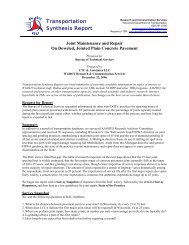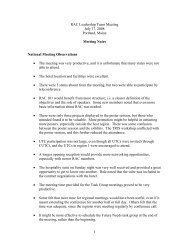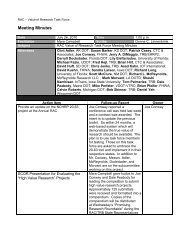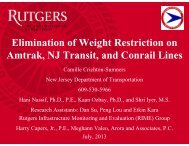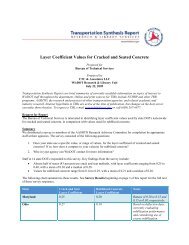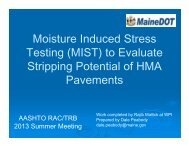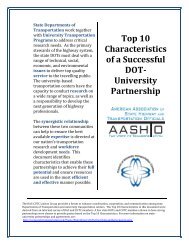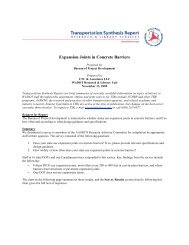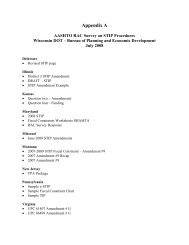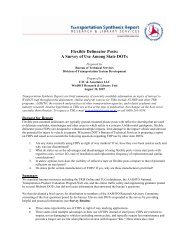PART IV: Summary of Comments - SCOR/RAC
PART IV: Summary of Comments - SCOR/RAC
PART IV: Summary of Comments - SCOR/RAC
Create successful ePaper yourself
Turn your PDF publications into a flip-book with our unique Google optimized e-Paper software.
<strong>PART</strong> <strong>IV</strong>: <strong>Summary</strong> <strong>of</strong> <strong>Comments</strong>17-May-10Reviewer <strong>Comments</strong> Distribution <strong>of</strong> Ratings■ Increasing the privatization and safety <strong>of</strong> rest areas is an important issue.■ A very good topic, but some <strong>of</strong> the proposed tasks are hard to complete.■ [Rating: 2] While this research would be desirable to support decisions to maintain or close rest areas, the likelihood <strong>of</strong>being able to quantify the safety impacts is low.Research Advisory Committee■ Rest areas are touted as needed for safety, but I'm not sure because unlike the 1950's, there are now many commercialopportunities for motorists to rest, eat, etc. Rest areas cost many millions per year ($14 million just in janitorial). Itwould be good to know to what extent safety is still a factor.■ There has not been studies showing before and after safety experience in safety rest areas. Therefore this research couldbe very valuable in comparing investments in these facilities versus other safety countermeasures. It would help prioritizeinvestments for maintenance and new construction.■ Decision makers and the public are making decisions about rest area closures without the benefit <strong>of</strong> knowing theexpected impact on crash risk. The advent <strong>of</strong> these facilities was to support driver safety as well as comfort. Thecommercial vehicle safety concerns should not be underestimated. (Design)Other■ [Rating: 4]Item #96:D-03Improved Test Methods for Construction QualityControl(17)(46)NR 0 1 2 3 4 5<strong>SCOR</strong> 2 2 5 5 3<strong>RAC</strong> 5 11 10 8 11 4Standing Committee on Research■ see SHRP 2 research program for activities that will address this need. It's resistance to application (largelyinstitutional/industry) more so than a need to improve test methods that's the problem here. There are advances in thetechnology which should be used to effectively monitor construction quality control. The problem statement is too broadand general. It should be focused on a specific area <strong>of</strong> construction quality control for example: moisture content or soilstiffness, and develop a problem statement specific to it. The high variability mentioned in the problem statement forASTM D698 is more <strong>of</strong> the method than moisture content measurement itself. Moreover, there are other problemstatements considered by NCHRP which deals with specific area <strong>of</strong> measurement (ex. Stiffness using LWD, NCHRP2011-E-04).■ California already has QA/QC test methods.■ A definite long term need, but will probably not achieve for 1.5 million. In our industry, once new testing equipment ismarket-ready, it is evaluated quite quickly. Would be surprised if there is market-ready test equipment that we are notaware <strong>of</strong>.■ [Rating: 4] There has been a need for better construction quality control and acceptance tests for a long time. Manytechnologies and ideas for improvements have been proposed but have come up short with respect to beingimplemented. SBIR and IDEA programs continue to fund test method development, and FHWA and state highwayagencies (through the SP&R program) have also made some progress in this area.Research Advisory Committee■ ODOT has in initiative to improve our project delivery and this should speed up processes.■ The concept <strong>of</strong> uniform test methods is one <strong>of</strong> extreme promise. Not aware <strong>of</strong> a nationwide quality issue directly relatedto erratic inspection tied to training.<strong>IV</strong>-70



